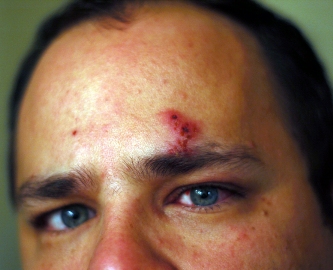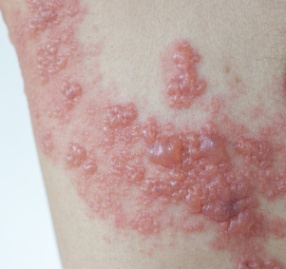
What do shingles look like? Shingles is a painful illness often accompanied by an unsightly rash. Shingles is the inflammation of nerves beneath the skin caused by the same virus as chickenpox, varicella-zoster. If you’ve been infected by chickenpox, no matter what age, you are at risk to also develop shingles. Shingles occur when the virus reactivates for reasons not fully understood, and moves through nerve pathways to the skin.
There’s no ambiguity when it comes to shingles, as the external symptoms are often startling and are also extremely painful. Outward signs of shingles typically include patches of fluid-filled blisters along one side of the body, which make the virus easy to identify.

Development of Shingles
Early symptoms of shingles can include fever and fatigue. Sharp senses of pain, burning, or tingling can also be an early indication of infection. The most clearly defining symptom of shingles is pain, which lasts through the duration of the illness and in some cases can be excruciating. This pain can sometimes be mistaken for other severe maladies involving other organs and can also manifest as burning, tingling, or even numbness.
Within a few days after initial symptoms, signs of a rash generally start to occur. While almost all people affected by shingles experience the intense symptoms of the shingles virus, such as pain, not everyone will develop the rash. If you do develop a rash, you will notice pink or red blotchy patches along one side of the body, as they cluster along nerve pathways. In many cases, due to the virus directly impacting nerves, there are shooting pains along the shingles rash.
What Do Shingles Look Like

The external signs of shingles that are plainly visible and develop over time are considered further evidence and confirmation of the disease. What do shingles look like? Well, the initial rash develops blisters that are filled with fluid, and are similar to chickenpox as they may itch and burn. Unlike chickenpox, however, blisters develop over a small patch on one side of the body – they typically do not spread. Most commonly, blisters manifest on the torso or face. We recommend seeking immediate medical attention if you experience any of the signs or symptoms associated with shingles for a proper diagnosis, particularly if any of these occur around the eye area, as this can lead to severe complications and potential loss of vision.
As they are filled with fluid, shingles blisters can break and ooze, at which point they are most contagious. As broken blisters begin to dry, over the course of one to two weeks, they develop scabs. Only when all shingles blisters have crusted over completely is there a lowered risk of transmitting the virus to others. While it is impossible to spread shingles to another person, anyone who has not had chickenpox is not immune to the varicella-zoster virus and has the potential to develop chickenpox as a result of direct contact with someone with shingles.
As shingles impacts sections of nerve pathways, the shingles rash tends to manifest and look like a belt or half-belt around the affected person. Common nicknames for the rash include the shingles band or girdle.
Other Types of Shingles
- Ophthalmic Shingles: Ophthalmic shingles impact the nerve that controls facial movement and generally manifests around the eye, nose, or forehead. Any sign or symptom indicating ophthalmic shingles should be tended to immediately by a professional.
- Widespread Shingles: While it is less common, in approximately 20 percent of cases the shingles rash can affect multiple nerve pathways and result in widespread rashes. The shingles rash, in this case, may at the first display like chickenpox. Those impacted by widespread shingles tend to have weaker immune systems.
To help treat shingles with a natural product, we suggest Naturasil for Shingles Remedy, a natural homeopathic formula made of plant extracts and without harsh chemicals. Naturasil for Shingles works to reduce or eliminate the symptoms associated with shingles and to aid your body in fighting against potential repeat outbreaks and can be used in conjunction with or in lieu of prescribed medication. We recommend you consult with your physician before trying this or any other over the counter treatment.
Ref: CDC – Shingles
